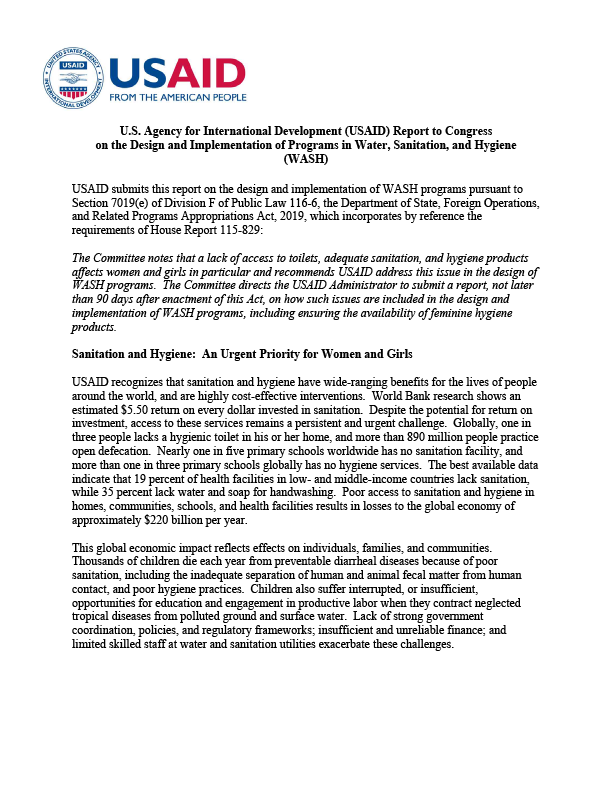Speeches Shim
U.S. Agency for International Development (USAID) Report to Congress on the Design and Implementation of Programs in Water, Sanitation, and Hygiene (WASH)
USAID submits this report on the design and implementation of WASH programs pursuant to Section 7019(e) of Division F of Public Law 116-6, the Department of State, Foreign Operations, and Related Programs Appropriations Act, 2019, which incorporates by reference the requirements of House Report 115-829:
The Committee notes that a lack of access to toilets, adequate sanitation, and hygiene products affects women and girls in particular and recommends USAID address this issue in the design of WASH programs. The Committee directs the USAID Administrator to submit a report, not later than 90 days after enactment of this Act, on how such issues are included in the design and implementation of WASH programs, including ensuring the availability of feminine hygiene products.
Sanitation and Hygiene: An Urgent Priority for Women and Girls
USAID recognizes that sanitation and hygiene have wide-ranging benefits for the lives of people around the world, and are highly cost-effective interventions. World Bank research shows an estimated $5.50 return on every dollar invested in sanitation. Despite the potential for return on investment, access to these services remains a persistent and urgent challenge. Globally, one in three people lacks a hygienic toilet in his or her home, and more than 890 million people practice open defecation. Nearly one in five primary schools worldwide has no sanitation facility, and more than one in three primary schools globally has no hygiene services. The best available data indicate that 19 percent of health facilities in low- and middle-income countries lack sanitation, while 35 percent lack water and soap for handwashing. Poor access to sanitation and hygiene in homes, communities, schools, and health facilities results in losses to the global economy of approximately $220 billion per year.
This global economic impact reflects effects on individuals, families, and communities. Thousands of children die each year from preventable diarrheal diseases because of poor sanitation, including the inadequate separation of human and animal fecal matter from human contact, and poor hygiene practices. Children also suffer interrupted, or insufficient, opportunities for education and engagement in productive labor when they contract neglected tropical diseases from polluted ground and surface water. Lack of strong government coordination, policies, and regulatory frameworks; insufficient and unreliable finance; and limited skilled staff at water and sanitation utilities exacerbate these challenges.
USAID recognizes that lack of access to safe sanitation facilities and sufficient water and supplies for hygiene, including for menstrual hygiene, disproportionately affect women and girls. Their unique needs for privacy can put them at risk of physical and sexual violence when they seek out sanitation facilities, especially at night. Female teachers and students suffer at schools without safe, private latrines that include sufficient hygiene facilities, supplies, and waste disposal for managing their menstrual hygiene. Female workers in both formal and informal labor face the same challenges. Poor sanitation has a domino effect: Ill health, absenteeism, the risk of an incomplete education or low-quality teaching, compromised livelihoods and productivity levels, and, ultimately, a compromised economy.
Women often do not have decision-making authority in their homes or communities, which prevents them from meeting their own needs for sanitation and hygiene. Women, men, girls, and boys lack accurate information about hygiene and menstruation, which can perpetuate harmful stereotypes, stigma, gender and cultural norms, and practices around menstruation. Lack of sanitation and hygiene in health facilities can contribute to infections such as sepsis (an important factor in maternal and newborn mortality), and to the spread of infectious diseases, such as cholera and Ebola. During humanitarian crises, women and girls generally face increased vulnerability to violence, exacerbated by a lack of access to sanitation and hygiene.


Comment
Make a general inquiry or suggest an improvement.